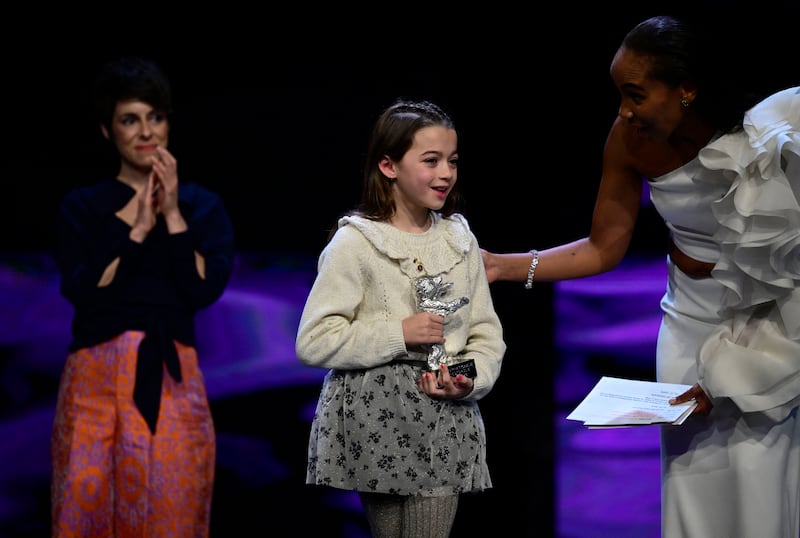Bees have a particular resonance for the Basque film-maker Estibaliz Urresola Solaguren, the writer and director of the Silver Bear-winning 20,000 Species of Bees. “The hive represents the meaning of community – and, specifically, community as an entity that’s greater than the individual,” she says. “And yet, within the hive, each member of the community has a role. You’ve got the drones, the queen, the worker bees. Every one of these is needed for the survival of the colony.”
In Basque tradition, which regards the insects as sacred, keepers would tell bees about births, marriages, deaths and other important events in their families.
“I discovered it through an old ballad that underscored the importance of the proximity between the family and the bees,” Solaguren says. “In Basque culture we refer to bees as ‘usted’ rather than ‘tú’,” which is to say address them with the respectful rather than the familiar form of “you”. “They are the only members of the animal kingdom that are addressed” like this, she says. “I was also interested in bees because people want to keep that distance; they fear getting stung. But when you spend time with bees you see their wisdom.”
The tradition of “telling the bees” finds contemporary application in 20,000 Species of Bees, in which an eight-year-old trans girl named Lucía (played by newcomer Sofía Otero) is no longer comfortable with her masculine given name, Aitor, or her family nickname, Coco. When she travels with her mother and occasionally bickering siblings to the Basque Country for an extended summer stay in her grandmother’s sleepy village, local tongues soon wag. Lucía’s grandmother suggests that Lucía needs a haircut and discipline, but her wise, beekeeping great-aunt, Lourdes (Ane Gabarain), proves a patient listener.
Dancing with the Stars: ‘I’ve had the best time of my life. I feel super fit,’ chef Kevin Dundon says as he is voted off show
Oscars 2025 red carpet: Ariana Grande sets the standard while Timothée Chalamet stood out in ‘Kerrygold’ yellow
Róisín Ingle puts a Thermomix to the test: ‘I am a convert but there’s one enormous catch’
The young protagonist’s questioning coincides with various personal and creative crises; her mother’s revived career in sculpture and her parents’ doomed marriage require a script that cleverly incorporates multiple perspectives.
“I didn’t feel like I could legitimately tell a story from only Lucía’s perspective,” says the film-maker. “I spoke a lot with the parents of trans children, and I realised that I felt more capable of identifying with them, particularly the mothers. But I realised that if I was to stay with the parents then I would very quickly lose the perspective of Lucía – and, in a way, that would replicate what happens in these families where they struggle to understand the perspective of their children.
“What I found talking to families was that the main transition happened in the families. The children, I discovered, always knew who they were, but they just lacked the ways to be able to express that. The main transition, rather than being in the child, was actually the transition that happened in the families.”
Solaguren’s film was inspired by death of Ekai Lersundi, a 16-year-old transgender boy from Ondarroa. He took his own life while waiting for hormonal treatment, leaving behind a note that praised his family and expressed the hope that his suffering might bring about change. Lersundi’s death, which shocked people in the Basque community and beyond, prompted Solaguren to contact Naizen, a local association for families with transsexual young people.
“This is in 2018, before there was an open dialogue in Spanish society about trans children,” she says. “There was no information out there. So I wanted to approach the relatives in this organisation and find out how it was, and how they addressed and embraced their children. I started a series of interviews with these relatives, and that process ran in parallel to writing the film.”

Naizen was the director’s first port of call for casting. She then widened the search for her heroine, meeting almost 500 children before finding Sofía Otero. “We went to theatre schools, dance schools, playgrounds, as we looked all over,” Solaguren says. “We needed a lot of kids for the film, so we had to see as many as possible to deliver many different roles. For the character of Lucía, we met girls and trans girls, but not boys. For me it wouldn’t have been honest if the main character was performing as a girl rather than feeling like a girl.”
I realised through the process of directing Sofía that I could go further and further with her performance, because we both shared the same language
— Estibaliz Urresola Solaguren
Last January, Sofía Otero became the youngest person to win an acting award in the 70-plus years of the Berlin Film Festival.
[ Texas becomes largest US state to ban transgender care for minorsOpens in new window ]
“I think that directing children is the same as directing adults,” Solaguren says. “It’s thinking about what moves them. It’s a relationship both with the crew and the actors. And with the children, I thought it was important to share my vision of the film and all the emotional processes that were going on. I realised through the process of directing Sofía that I could go further and further with her performance, because we both shared the same language. Sofía had a really strong capacity to understand emotions.”
20,000 Species of Bees opens on Friday, October 27th; it is also available on Curzon Home Cinema


















